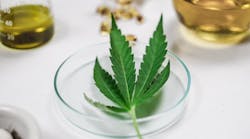Dental plaque is a complex biofilm that accumulates on the surface of teeth and tissue within the oral cavity. It serves as a reservoir for multiple bacterial pathogens that function as causative agents for various dental problems (e.g., caries, periodontal disease, halitosis, and gingival inflammation). Consistent management, removal, and suppression of these pathogens will reduce oral disease.
Preclinical evidence of cannabinoid compounds found in the Cannabis sativa plant exhibit antimicrobial properties. New uses of cannabinoids within the dental field require further investigation, but the literature does show positive results. The addition of cannabinoids to air polishing powder, toothpaste, and oral rinses could increase product effectiveness when it comes to controlling plaque biofilm.1,2
History of use
Cannabis sativa is an herbaceous plant belonging to the family Cannabinaceae and has been used for thousands of years for medicinal and recreational purposes.3 The Cannabis sativa plant is most commonly known for its use as marijuana, a drug that produces psychotropic effects when ingested or smoked. However, due to its antimicrobial and anti-inflammatory properties, there are more uses for this plant.
Structure and composition
The chemical composition of the Cannabis sativa plant is complex, including cannabinoids, flavonoids, and terpenes. Around 120 cannabinoids are present, many of which are considered to have pharmacological benefits. They can be found throughout the plant, but are found in more significant amounts within portions of the female flower.4
The most common cannabinoid is delta-9-tetrahydrocannabinol (THC), which has the potential to produce a “high” as well as unwanted psychotropic effects such as impaired motor skills, extreme euphoria, and lack of self-regulation.3 However, other cannabinoids such as cannabidiol (CBD), cannabigerol (CBG), cannabinol (CBN), and cannabichromene (CBC) are nonpsychotropic. Some cannabinoids have beneficial anticonvulsive, analgesic, and antianxiety effects. Cannabinoids bind to receptors in human immune cells. This fact suggests that triggering these receptors could regulate the body’s immune system during infection. Cannabidiol (CBD) and cannabigerol (CBG) are a few compounds that can provide these beneficial effects.3,4
Therapeutic potential of CBD
Cannabinoids’ antibacterial activity has been actively researched since the 1950s, and has only gained popularity.3 A 1976 study by van Klingeren and ten Ham found that certain cannabinoids, such as THC and CBD, are bacteriostatic and bactericidal against a selection of gram-positive pathogens, including S. aureus and Streptococcus.5 Early research suggests that cannabinoids have the potential to inhibit plaque formation, reduce the metabolic activity of existing biofilms, and enhance the antibacterial effectiveness of antibiotics on gram-positive and gram-negative bacteria, including Streptococcus mutans, Fusobacterium, and Actinobacteria.6,7 This is valuable information for dental hygienists. We regularly address accumulated biofilm on our patients’ teeth and educate them on the responsibility to control this accumulation through consistent home care. The addition of a natural antibiofilm, antibacterial product would greatly benefit patients’ oral health.
Applications in oral care
The bacteria present in dental plaque are causative factors for dental diseases. As such, patients should adhere to regular removal of this bacteria through brushing, flossing, and using toothpaste and antiseptic rinses. Comparative studies on reducing plaque bacteria by standard oral care products and cannabinoids are currently underway. In 2019, Stahl et al. gathered data on the efficacy of cannabinoids in oral care products. Their findings reveal that “cannabinoids were more effective in reducing the bacterial content of the dental plaque compared to the commercially available synthetic oral care products.”1,8
Related consumer CBD products on the market
With the advancement of science and in-depth studies on the anti-inflammatory properties of CBD, more and more oral health companies have begun manufacturing oral products containing CBD (figure 1). This list is for educational purposes only; the authors do not officially endorse any of these products.
Safety, toxicity, and testing
Since 2020, medical marijuana (THC) and CBD have been legalized in all but four states and approved for recreational use in 11 states and Washington, DC.9 The Food and Drug Administration (FDA) is the federal agency responsible for approving and regulating drugs and medical products to ensure safety and effectiveness. The FDA has approved only one CBD-containing medication to date: Epidiolex, a drug used to treat specific seizure-inducing diseases.9 Studies continue to explore the safe and effective use of cannabinoids in consumer products, but safety and product quality need continued investigation. Consumers may incorrectly assume that all CBD products are safe because they’re all-natural. Consumers should be aware of the following potential risks of CBD products:10
- CBD can cause liver injury
- CBD can cause adverse drug interaction or side effects
- CBD can cause a reaction when mixed with alcohol or other drugs
- Reproductive toxicity or damage to fertility has been reported in animal studies.
Passing the drug test
Cannabidiol (CBD) should not show up on a drug test because the drug test designed to detect the use of cannabis derivatives is more specific to the compound THC. However, some CBD formulations may contain trace amounts of THC and potentially lead to a positive drug test. The potential for impure products depends on how the CBD manufacturer harvests the plant and extracts the compound. Understanding where CBD ingredients are derived from is an excellent place to start.9
Conclusions
The main takeaway here is that CBD is an emerging player in the control of inflammation. Patients will start seeing more and more products on the shelves and they’ll begin to ask questions. Unfortunately, there’s no magic pill or potion that will eradicate inflammation. Yes, some studies have shown a reduction of inflammation with these products. However, none of these products currently carry the American Dental Association (ADA) seal of approval, and for many, that is a deal breaker. However, we all have patients who will only use these types of products. No matter what adjunctive product a patient is using, it will never replace mechanical brushing and flossing to disrupt and remove plaque and biofilm. The CBD market is a fast-growing segment to follow. Continual reading and researching to stay abreast of current trends, evidence-based results, and research is the best way we, as providers, can stay informed and able to advise our patients as this market continues to develop.
References
- Stahl V, Vasudevan K. Comparison of efficacy of cannabinoids versus commercial oral care products in reducing bacterial content from dental plaque: A preliminary observation. Cureus. 2020;12(1):e6809. doi:10.7759/cureus.6809
- Vasudevan K, Stahl V. CBD-supplemented polishing powder enhances tooth polishing by inhibiting dental plaque bacteria. J Int Soc Prev Community Dent. 2020;10(6):766-770. doi:10.4103/jispcd.JISPCD_351_20
- Karas JA, Wong LJM, Paulin OKA, et al. The antimicrobial activity of cannabinoids. Antibiotics (Basel). 2020;9(7):406. doi:10.3390/antibiotics9070406
- Schofs L, Sparo MD, Sánchez Bruni SF. The antimicrobial effect behind Cannabis sativa. Pharmacol Res Perspect. 2021;9(2):e00761. doi:10.1002/prp2.761
- van Klingeren B, ten Ham M. Antibacterial activity of Δ9-tetrahydrocannabinol and cannabidiol. Antonie van Leeuwenhoek. 1976;42(1-2):9-12. doi:10.1007/BF00399444
- Vasudevan K, Stahl V. Cannabinoids infused mouthwash products are as effective as chlorhexidine on inhibition of total-culturable bacterial content in dental plaque samples. J Cannabis Res. 2020;2(1):20. doi:10.1186/s42238-020-00027-z
- Feldman M, Sionov RV, Mechoulam R, Steinberg D. Anti-biofilm activity of cannabidiol against Candida albicans. Microorganisms. 2021;9(2):441. doi:10.3390/microorganisms9020441
- Baswan SM, Klosner AE, Glynn K, et al. Therapeutic potential of cannabidiol (CBD) for skin health and disorders. Clin Cosmet Investig Dermatol. 2020;13:927-942. doi:10.2147/CCID.S286411
- Karschner EL, Swortwood-Gates MJ, Huestis MA. Identifying and quantifying cannabinoids in biological matrices in the medical and legal cannabis era. Clin Chem. 2020;66(7):888-914. doi:10.1093/clinchem/hvaa113
- What you need to know (and what we’re working to find out) about products containing cannabis or cannabis-derived compounds, including CBD. US Food and Drug Administration. www.fda.gov/consumers/consumer-updates/what-you-need-know-and-what-were-working-find-out-about-products-containing-cannabis-or-cannabis









